Unlocking Blooms: Essential Tips for Fertilizing Your Hydrangeas
- Jen Dayton
- Aug 1, 2024
- 2 min read
Hey there, fellow garden enthusiasts!
As someone who adores hydrangeas, I'm thrilled to share some insider tips on nurturing these stunning blooms.
Here's a comprehensive guide to help your hydrangeas thrive this season.
Understanding Hydrangeas: Did you know hydrangeas come in several types, each requiring slightly different care? From mophead (big, round blooms) to lace cap (flatter, delicate blooms), identifying your hydrangea type helps tailor care practices for optimal growth.

Step #1 - Prep for Success
Start by trimming no more than 1/3 of last season’s living stems. This ensures your hydrangeas have the proper foundation to flourish. Remember, pruning timing and method can influence bloom production—so prune wisely!
Step #2 - Timing is Key
Fertilize twice annually for optimal results—once in mid to late spring and again in mid-summer. This strategic timing boosts growth and enhances bloom size. For those in colder climates, consider delaying spring fertilization until after the last frost to protect new growth.
Step #3 - The Right Formula

Opt for a slow-release, granular acid line fertilizer. My go-to is Espoma Organic, which provides the natural nourishment that hydrangeas love. This type of fertilizer gradually releases nutrients, providing sustained nourishment throughout the growing season.
Step#4 - Application Technique
Spread the fertilizer evenly along the drip line, gently scratching it into the soil’s surface to prevent runoff. Water thoroughly after application to help nutrients penetrate deep into the root zone. Remember, hydrangeas appreciate consistent moisture, especially during hot summer months.
Miracle-Free Zone: Avoid Miracle-Gro and similar products, as hydrangeas thrive best with a more organic approach. Chemical fertilizers can alter soil pH, affecting bloom color and overall plant health. Stick with organic options like compost or specialized hydrangea fertilizers for sustainable growth.
Bonus Tips for Blooming Success:
Sun and Shade: Most hydrangeas prefer morning sun with afternoon shade, especially in warmer climates. This balance protects delicate blooms from scorching and encourages healthy growth.
Mulch Matters: Apply a 2-3 inch layer of organic mulch around the base of your hydrangeas to retain moisture, regulate soil temperature, and suppress weeds. This extra layer of protection also enhances soil structure over time.
Let’s watch those blooms burst with vibrancy this year! Stay tuned for updates on my hydrangea journey—I can’t wait to see the results. 🪴✨
Happy gardening!
-Jen

Comments